Joget vs Bubble for App Development: A Strategic Comparison
Date
Sep 03, 25
Reading Time
9 Minutes
Category
Low-Code/No-Code Development
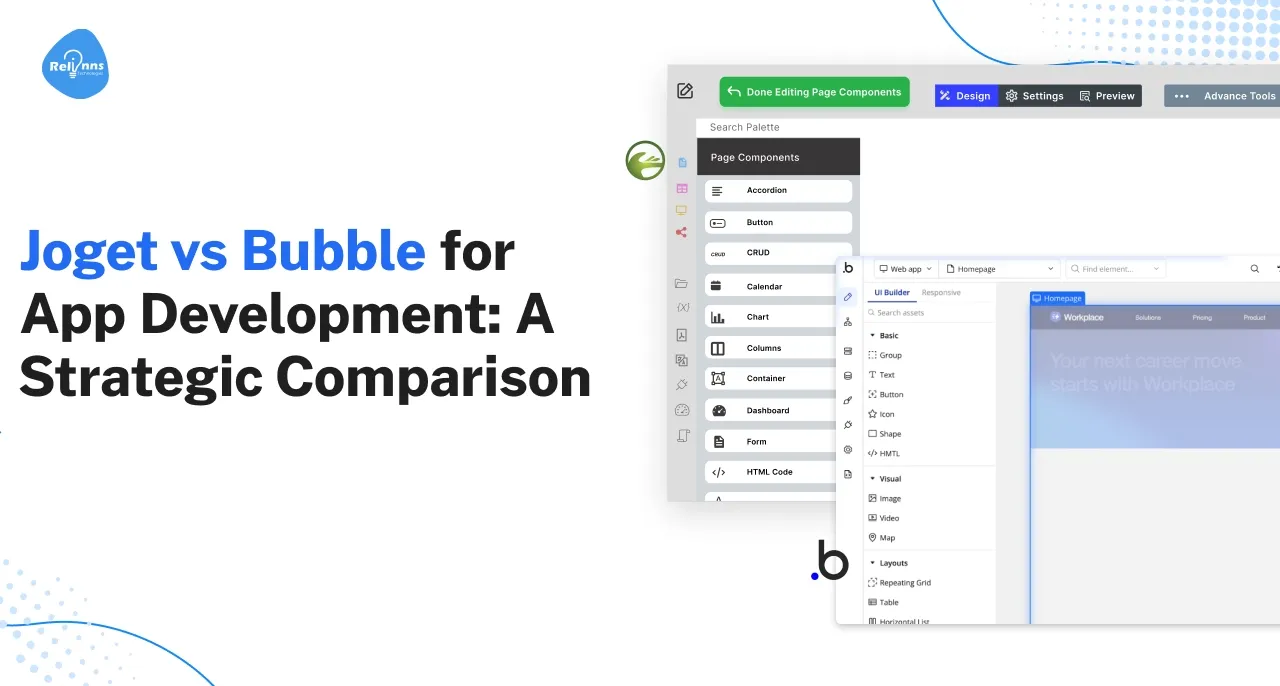
Enterprise leaders are building applications faster with low-code tools.
Gartner predicts 70% of new apps by 2025 will use low-code/no-code. This growth is evident in Asia-Pacific (26.1% CAGR) and across global markets.
A side-by-side Joget vs Bubble assessment is crucial for organizations exploring new digital initiatives (ensuring the platform choice aligns with long-term goals).
Low-code adoption is global. Forrester notes nearly 60% of EMEA enterprises now view low-code as critical to strategy. Joget has built traction in North America, Europe, the Middle East/Africa, and Asia-Pacific, while Bubble.io powers millions of apps globally, including startups and SMBs in over 200 countries.
This Joget vs Bubble comparison will help B2B decision-makers weigh features, scalability, deployment models, and pricing to determine which tool fits their app development roadmap.
What is Bubble?
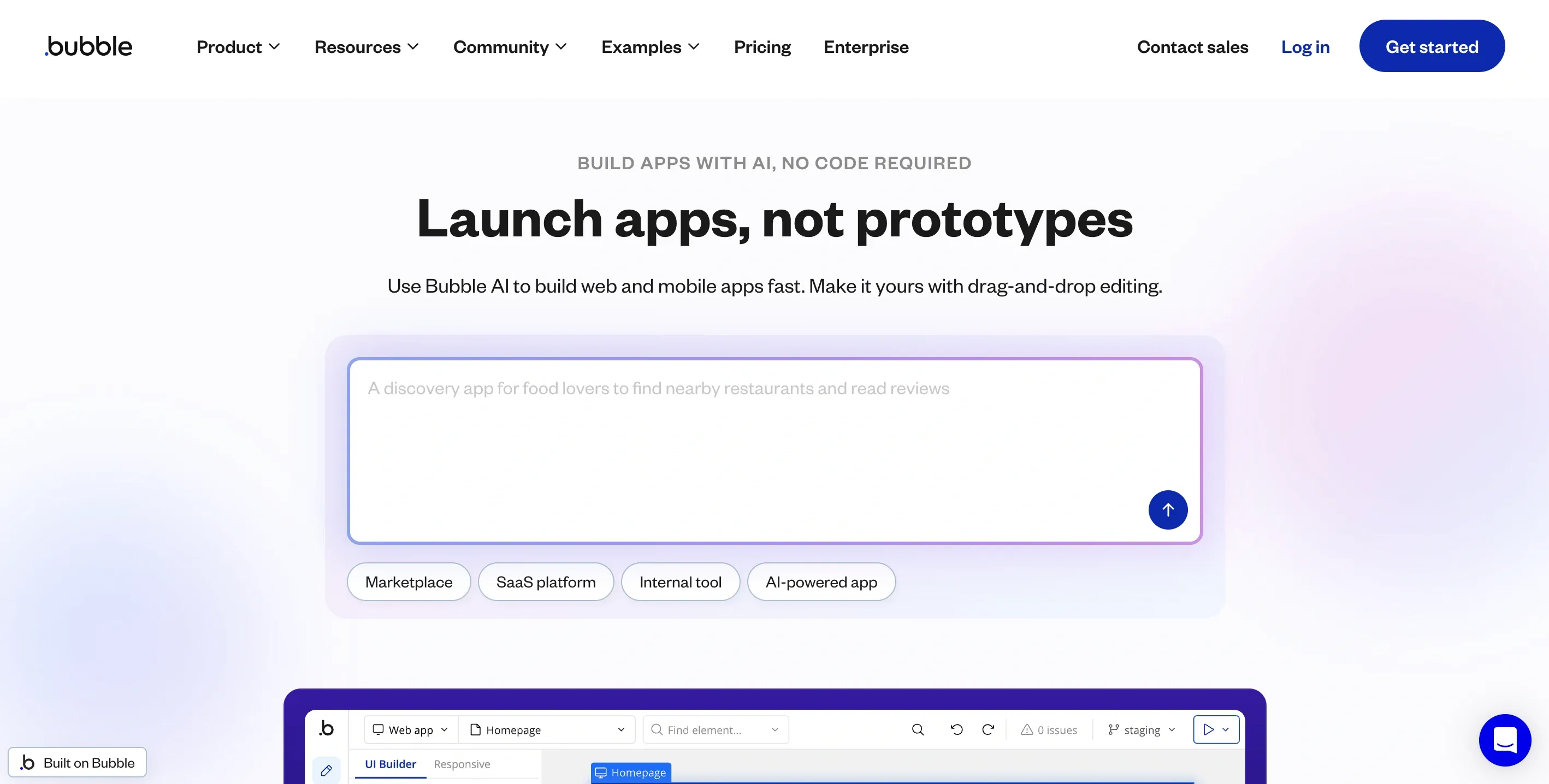
Bubble.io is a popular no-code platform for startups and SMBs, designed to create fully functional web applications without traditional coding.
It offers a drag-and-drop visual editor, built-in database, and plugin marketplace for extending functionality.
App Development Features Comparison: Joget DX vs Bubble
Choosing between Joget and Bubble depends on the type of application you want to build.
Key Similarities: Joget DX vs Bubble
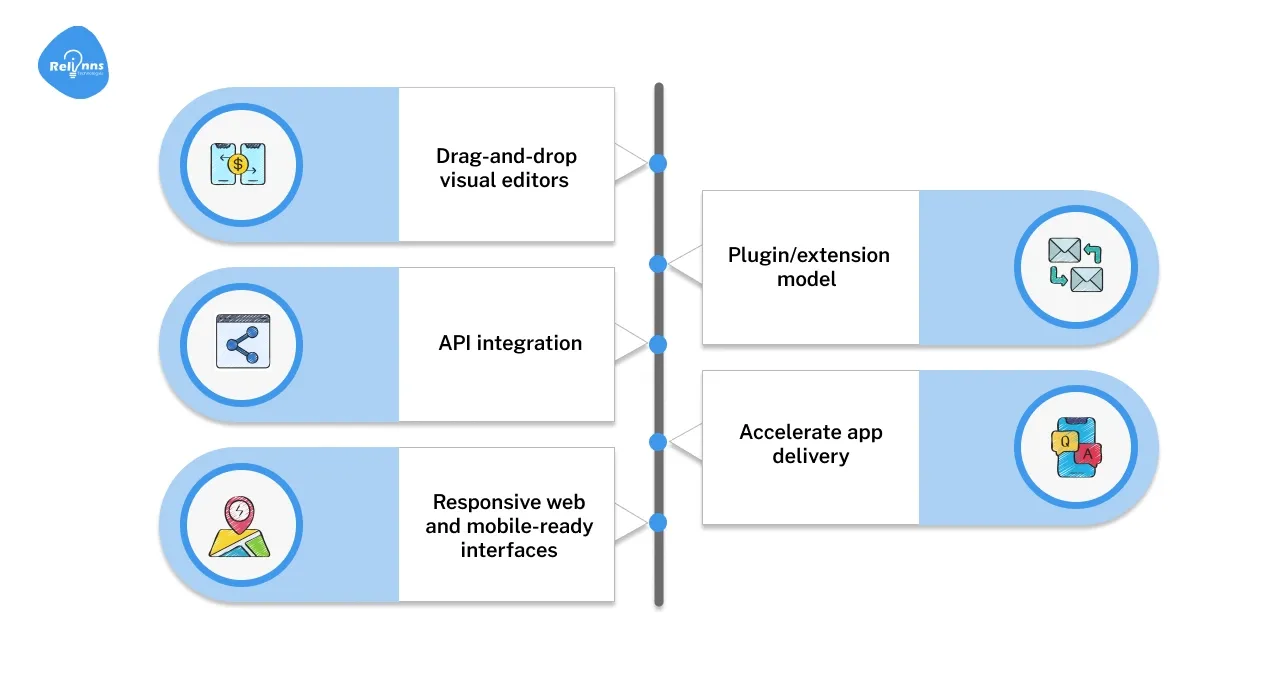
Both Joget and Bubble share foundational low-code/no-code features that make application development faster.
- Both platforms provide drag-and-drop visual editors for building applications without heavy coding.
- Each supports API integration to connect with external services and enterprise systems.
- Both include responsive web and mobile-ready interfaces for accessibility across devices.
- Each platform has a plugin/extension model for adding third-party or custom functionality.
- Both aim to accelerate app delivery by reducing manual coding and streamlining workflows.
Key Differences: Joget vs Bubble
Despite these similarities, the two platforms diverge in how they approach scalability, compliance, and target use cases.
| Feature | Joget Highlights | Bubble Highlights |
| Target Audience | Mid-to-large enterprises, governments, regulated industries | Startups, SMBs, solopreneurs, SaaS developers |
| Deployment Options | On-premises, private cloud, or cloud-native with Docker & Kubernetes | Fully managed cloud hosting only |
| Customization | Extendable with Java plugins, REST APIs, and enterprise systems | Visual editor with plugins; custom code only via API Connector |
| Workflow Automation | Built-in workflow engine, process automation, form builders | No workflow engine; relies on logic workflows in the visual editor |
| Security/Compliance | ISO 27001, SOC 2, enterprise certifications | HTTPS, Cloudflare, role-based access, less enterprise compliance focus |
| Scalability | Suited for large deployments with clustering and Kubernetes support | Scales via workload units (Bubble-hosted environment only) |
| Integration | Strong ERP, CRM, and legacy system integration | API Connector + marketplace plugins for SaaS tools |
| Pricing | Community edition free, Enterprise ~$120/user/year | Free tier, paid plans from $29/month to $349/month |
| Community/Support | 12k+ community members, forums, enterprise-grade support | Millions of builders, large forum, enterprise support available |
This Bubble vs. Joget DX Comparison makes it clear: Joget excels in enterprise workflow automation and compliance-heavy deployments, while Bubble shines in startup environments where speed and MVP development matter most.
Pros and Cons: Joget vs Bubble
Both Joget and Bubble lower the barrier to building applications, but each comes with its strengths and trade-offs. Evaluating the pros and cons of Joget vs. Bubble helps organizations understand which platform better aligns with their development needs.
Pros and Cons of Joget DX Summary
Joget is designed for enterprise-grade process automation, but its complexity may be higher compared to startup-oriented tools.
Pros of Joget | Cons of Joget |
| Open-source platform with a free Community Edition for adoption flexibility. | Steeper learning curve for small teams or non-technical users. |
| Strong workflow automation engine for enterprise-level business processes. | Pricing model (~$120/user/year) may scale high in large organizations. |
| Supports on-premises, cloud-native, and hybrid deployment options. | Limited UI/UX flexibility compared to Bubble’s design-oriented editor. |
| Provides enterprise certifications like ISO 27001 and SOC 2 compliance. | Smaller community compared to Bubble’s large ecosystem. |
| Extensible via plugins, APIs, and ERP/legacy system integration. | Best suited for enterprises — less ideal for MVP-focused startups. |
Pros and Cons of Bubble Summary
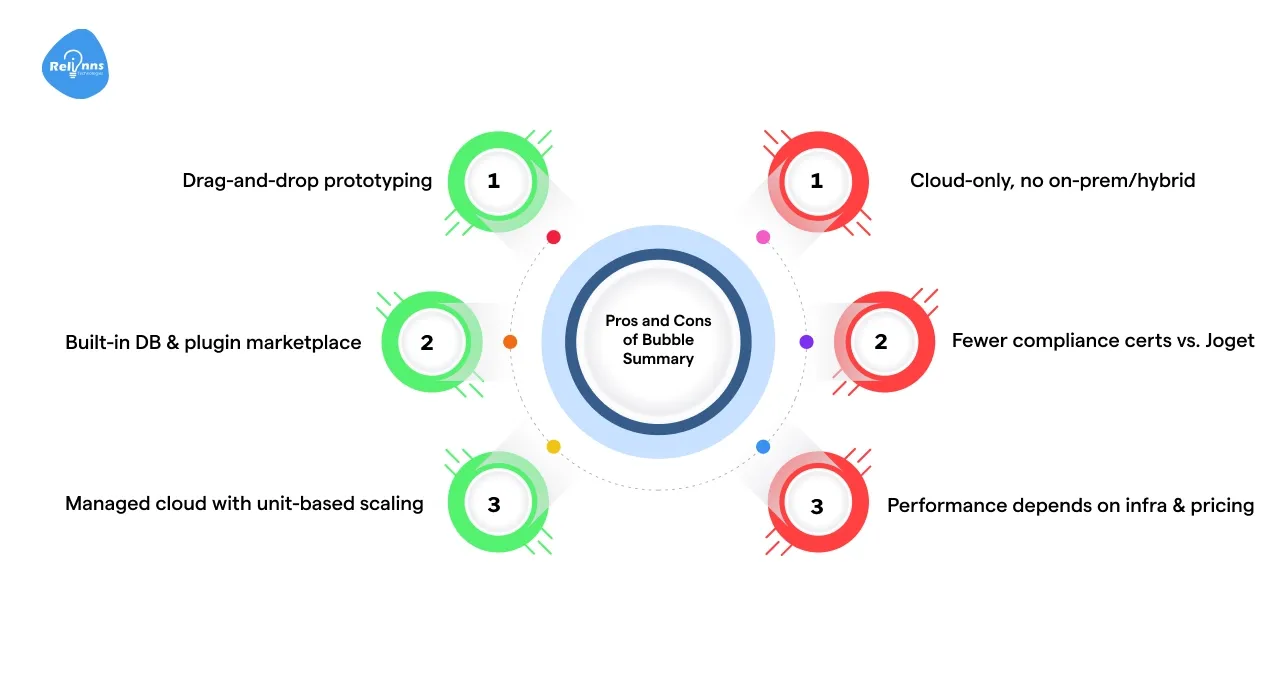
Bubble is widely adopted by startups and solopreneurs due to its ease of use, but enterprise-level needs may stretch its capabilities.
Pros of Bubble | Cons of Bubble |
| Simple drag-and-drop interface for rapid app prototyping. | No on-premises or hybrid deployment options (cloud-only). |
| Built-in database and plugin marketplace for quick feature extensions. | Limited enterprise compliance certifications compared to Joget. |
| Fully managed cloud hosting with workload unit–based scaling. | Performance tied to Bubble’s infrastructure and workload pricing. |
| Large and active community of millions of builders worldwide. | Customization depends on plugins and API connector, limiting deep control. |
| Affordable entry pricing with a free tier for small projects. | May not scale easily for complex enterprise workflows. |
A. Scalability and Performance: Joget vs Bubble
Integration is crucial in enterprise applications.
Joget provides built-in database connectors for MySQL, PostgreSQL, and SQL Server, along with native REST/SOAP support.
Bubble, on the other hand, leans on a large plugin marketplace and an API Connector to integrate third-party services such as Stripe, Google, and AWS.
Key Difference: Both platforms enable robust API integration, but Joget is developer-extensible, while Bubble emphasizes ease of use with ready-to-go plugins for common integrations.
| Factor | Joget DX | Bubble.io |
| Scaling | Manual cluster setup with Docker/Kubernetes for fine-grained control. | Automatic workload-based scaling in managed cloud. |
| Footprint | Strong for small-to-mid workloads and on-premises deployments. | Optimized for SaaS and consumer-facing applications. |
| Availability | Requires manual clustering and failover configurations. | Built-in failover and SLA-backed uptime guarantees. |
| Monitoring | Basic monitoring, dependent on enterprise infrastructure. | Advanced usage and performance analytics in the dashboard. |
| Best Fit | Enterprises needing compliance-heavy, high-control environments. | Startups and SMBs seeking fast, low-maintenance scalability. |
B. Customization and Development Speed: Joget vs Bubble
Speed and flexibility are two of the biggest reasons businesses consider Joget vs Bubble.
Joget is designed for rapid no-code prototyping of enterprise workflows. Business users can design forms, automate processes, and iterate quickly without developer support.
Bubble excels at fast visual development for web and SaaS products. Its drag-and-drop interface, reusable templates, and plugin marketplace make it easy to launch MVPs within days.
Key Difference: Joget offers deep customization with enterprise workflows, while Bubble focuses on rapid launches and lean iteration for customer-facing apps.
| Factor | Joget DX | Bubble.io |
| Development Style | Visual builder for workflows and forms; optional code extensions. | Visual builder with templates; API logic for custom needs. |
| Speed | 40–60% faster delivery vs traditional dev for enterprise apps. | MVPs live in days; SaaS products built in weeks. |
| Agility | Iterations by citizen developers without heavy IT support. | Fast iteration with reusable blocks and plugins. |
| Customization | Deep integration and plugin-based custom workflows. | Limited; advanced features need API scripts or workarounds. |
| Best Fit | Enterprise workflows with controlled, governed customizations. | Startups and SMBs focused on speed and market entry. |
Suggested Read: Joget vs Pega: Which Is the Smarter Choice for Enterprises?
C. Security and Compliance: Joget vs Bubble
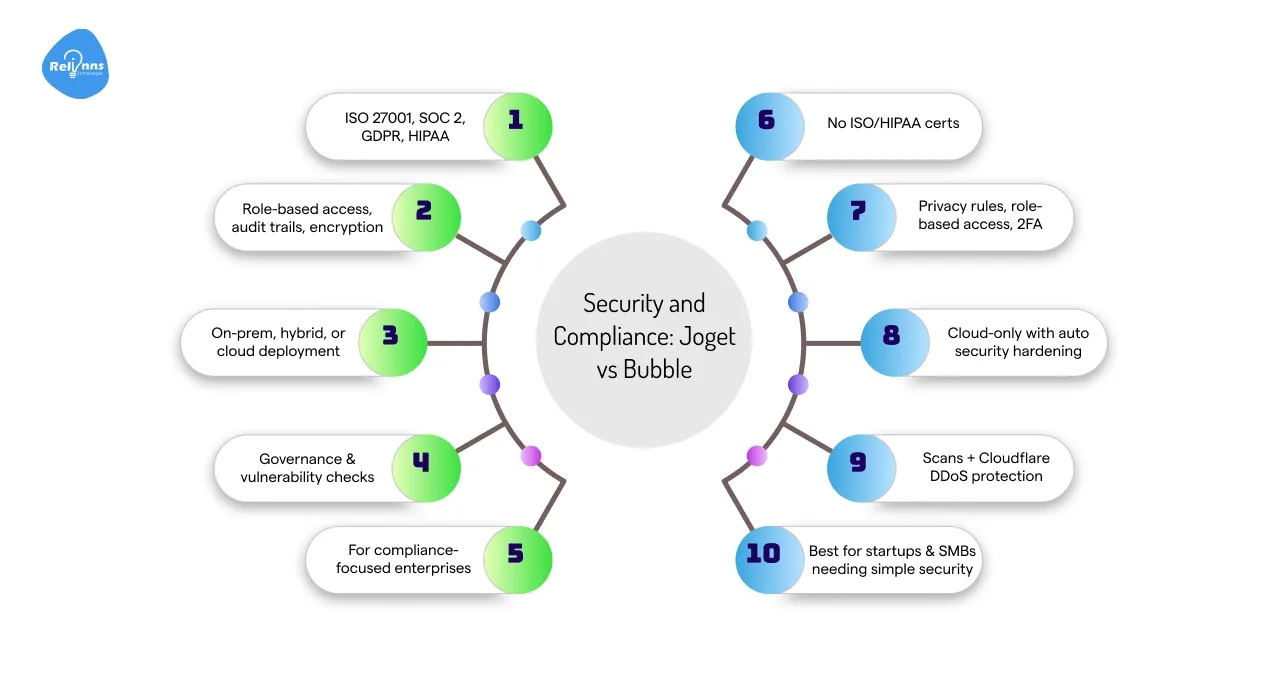
Enterprises demand strong security and compliance, and both platforms deliver — but in different ways.
Joget is enterprise-certified with ISO 27001 and SOC 2 compliance, making it ideal for regulated industries like finance, healthcare, or government.
Bubble offers robust security features like HTTPS, two-factor authentication, and role-based permissions.
Key Difference: Joget prioritizes enterprise compliance and deployment flexibility, while Bubble focuses on cloud-first security that’s simple but less customizable for regulated industries.
Factor | Joget DX | Bubble.io |
| Certifications | ISO 27001, SOC 2, GDPR, HIPAA options. | No formal ISO or HIPAA certifications. |
| Access Control | Role-based permissions, audit trails, and encryption. | Privacy rules, role-based access, and two-factor login. |
| Deployment Security | On-prem, hybrid, or cloud with full data control. | Cloud-only with automated security hardening. |
| DevOps Security | Governance tools, audit logs, and vulnerability checks. | Automated scans and Cloudflare DDoS protection. |
| Best Fit | Enterprises needing compliance and data sovereignty. | Startups and SMBs prioritizing simple, built-in security. |
D. Support and Community: Joget vs Bubble
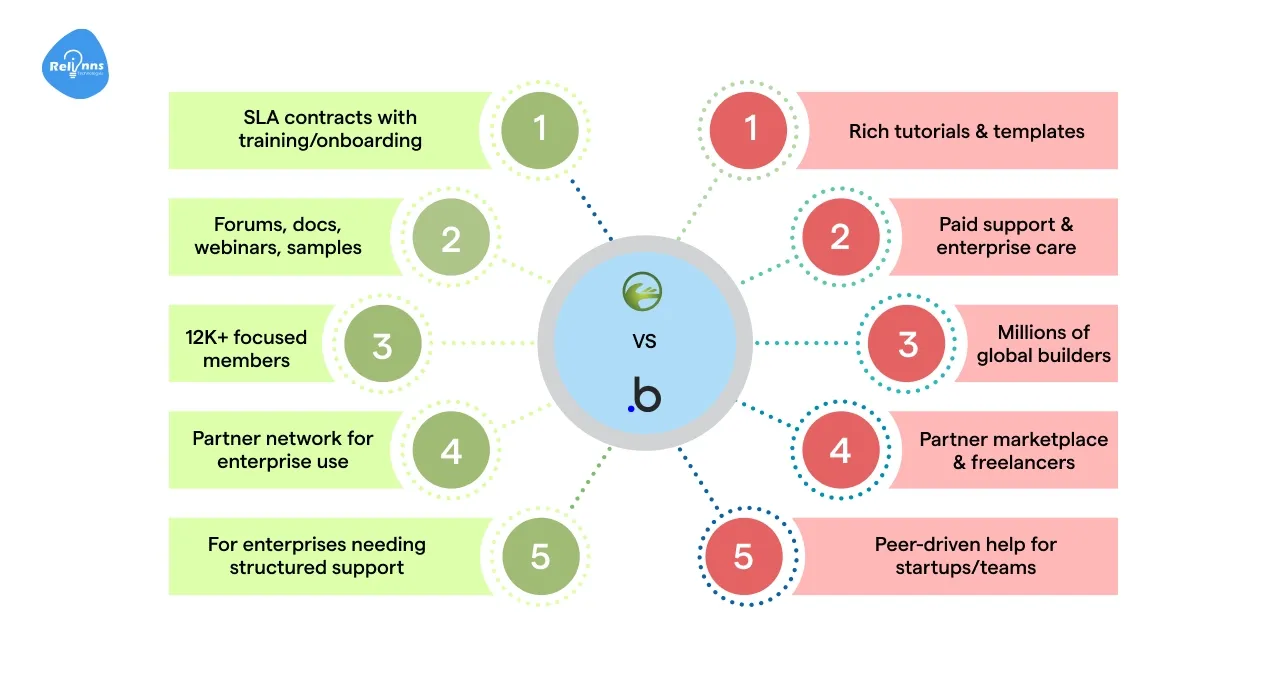
Strong community support and reliable vendor assistance are critical when choosing between Joget vs Bubble.
Joget maintains an active open-source community of over 12,000 members, with discussion forums, documentation, and sample projects.
Bubble, on the other hand, benefits from its massive global user base. With millions of builders, a vibrant forum, and a rich ecosystem of tutorials, templates, and agencies, finding answers or partners is quick and easy.
Key Difference: Joget provides deep technical support and governance-focused help, while Bubble thrives on its community scale and third-party resources that accelerate learning and troubleshooting.
Factor | Joget DX | Bubble.io |
| Community Size | 12,000+ members, smaller but focused. | Millions of builders, global reach. |
| Resources | Forums, documentation, webinars, and sample projects. | Extensive tutorials, templates, and learning resources. |
| Professional Support | SLA-backed contracts with training and onboarding. | Paid support tiers with priority responses and enterprise care. |
| Ecosystem | Partner network for enterprise deployments. | Agencies, freelancers, and a wide partner marketplace. |
| Best Fit | Enterprises needing structured, reliable support. | Startups and teams benefiting from peer-driven help. |
Suggested Reading: Joget DX vs Mendix: A Strategic Enterprise Comparison (2025)
Use Cases: Joget DX vs Bubble
Both Joget and Bubble have been proven across industries — but their strengths shine in different types of projects. Joget is most effective for enterprise-grade workflow automation, while Bubble is widely used for consumer-facing SaaS and startup MVPs.
A. Joget DX Use Case – Inventory Automation with Relinns
Challenge: A mid-sized retail chain was facing inventory inaccuracies, delayed restocking, and limited visibility across multiple store locations. Manual processes and disconnected tools were creating inefficiencies and revenue loss.
Solution: Relinns implemented a Joget DX–powered inventory management system. The solution included the following
- Automated stock tracking and low-inventory alerts.
- Centralized dashboards with real-time analytics.
- Seamless integration with warehouse and POS systems.
- Role-based access for store managers and operations teams.
Results
- Achieved 95% stock accuracy, reducing errors and shrinkage.
- Cut restocking cycles by 40%, improving product availability.
- Scaled the solution across multiple branches within weeks.
- Increased operational efficiency and visibility across all regions.
Why it worked: Joget’s workflow automation and integration flexibility gave Relinns the ability to customize the solution to the client’s exact needs while ensuring rapid deployment.
See more here: Relinns Inventory Management Case Study
B. Bubble.io Use Case – Startup MVP to Global SaaS
Challenge: A fintech startup needed to launch a customer-facing platform for peer-to-peer transactions. The goal was to release an MVP in under 60 days to test the market, without hiring a full development team.
Solution: Using Bubble’s visual builder and plugin marketplace
- Designed a fully responsive web app without coding.
- Integrated Stripe and email automation with API Connector.
- Leveraged pre-built templates to accelerate UI development.
Results
- Launched MVP within 6 weeks, gaining 1,000 users in the first month.
- Secured seed funding due to quick time-to-market.
- Scaled smoothly with Bubble’s cloud-based auto-scaling for increased traffic.
Why it worked: Bubble’s ease-of-use and low setup cost allowed the founders to validate their idea quickly and scale as demand grew — all without complex backend management.
See more here: Bubble.io Customer Stories
Pricing Comparison: Joget vs Bubble
Both platforms provide free entry tiers and scalable paid plans, but their pricing models differ significantly.
Plan / Tier | Joget DX (Annual) | Bubble.io (Monthly) |
| Free | Community Edition (GPL, unlimited users, open-source). | Free plan (50k Workload Units). |
| Starter / Basic | Entry-level packs at ~$120/user/year. | Starter Plan – $29/month, 175k WU. |
| Professional / Growth | Enterprise packs with premium support (~$10–15/user/month). | Growth Plan – $119/month, 250k WU. |
| Team / Advanced | Flexible enterprise pricing with on-premises or hybrid deployment. | Team Plan – $349/month, 500k WU. |
| Enterprise | Custom enterprise pricing for large deployments. | Enterprise – custom pricing with SLA support and dedicated infrastructure. |
Which Tool Is Best for Your App Development? – Joget vs Bubble
Choosing between Joget vs Bubble ultimately depends on your business goals, technical needs, and growth plans. Both platforms accelerate app delivery, but their strengths cater to different audiences.
For Enterprises and Regulated Industries
- Joget is ideal for organizations that need enterprise-grade security, compliance, and on-premises or hybrid deployment.
For Startups and Rapid MVPs
- Bubble is perfect for startups, small businesses, or product teams looking to prototype quickly and launch customer-facing apps without hiring a full dev team.
For Hybrid Needs
- Businesses seeking a mix of enterprise-level reliability and speed-to-market often explore partners like Relinns.
Decision Pointers
Scenario | Recommended Platform |
| Regulated industries needing strict compliance and control. | Joget DX |
| Startups needing rapid MVP deployment with minimal cost. | Bubble.io |
| Mid-sized teams balancing governance and speed. | Joget DX with Relinns support |
| Multi-app ecosystems requiring deep integrations. | Joget DX |
| Quick validation of consumer-facing SaaS or marketplaces. | Bubble.io |
Final Thoughts on Joget vs Bubble for App Development
When evaluating Joget vs Bubble, the decision often comes down to project scale, compliance needs, and long-term growth plans.
Joget DX excels as a cost-effective, enterprise-ready platform for organizations that need controlled deployments, workflow automation, and compliance. Its open-source flexibility and on-premise options make it ideal for businesses seeking high governance and scalability.
Bubble.io, meanwhile, dominates in rapid prototyping and startup environments, where speed-to-market and minimal upfront investment matter most. Its visual editor and plugin ecosystem empower lean teams to quickly launch functional, polished apps.
Both platforms deliver exceptional value, but their strengths cater to different use cases. Businesses often benefit from a quick proof of concept on each platform before committing, ensuring the chosen tool aligns perfectly with their strategy and capacity.
Why Choose Relinns?
Relinns is a trusted partner for businesses exploring both Joget and Bubble solutions.
With over 200 successful apps delivered, Relinns blends speed, scalability, and enterprise-grade support to help clients maximize their platform investment.
- 90% of workflows need no coding, boosting development speed.
- 40% faster app deployment compared with top competitors.
- Workflow errors reduced by up to an impressive 75%.
- Compatible with 95% of enterprise collaboration and productivity tools.
- Workflow updates deploy 60% faster using visual no-code tools.
Whether you need workflow automation with Joget or rapid MVP development with Bubble, Relinns ensures your app is future-proof, scalable, and delivered on time.
Frequently Asked Questions (FAQ's)|
Can Joget integrate with AI tools better than Bubble?
Yes, Joget offers plugin-driven AI integrations for workflows, while Bubble relies on third-party APIs. Joget’s enterprise connectors make it stronger for AI-enhanced automation at scale.
Does Bubble support multi-language apps like Joget does?
Bubble allows localization using plugins or workflows. Joget, however, includes native multi-language support, making it more straightforward for enterprises targeting diverse global audiences without additional configuration.
Are offline app capabilities possible on Bubble compared to Joget?
Bubble is primarily cloud-only, so offline capabilities require workarounds. Joget supports hybrid deployments, enabling offline-ready apps for enterprises needing continuity during connectivity interruptions.
Which platform provides better DevOps integration: Joget or Bubble?
Joget supports CI/CD pipelines, Kubernetes, and containerization out of the box. Bubble lacks native DevOps tools but can integrate through APIs or external services for deployment automation.
Can Bubble or Joget handle IoT applications effectively?
Joget integrates with IoT data pipelines using APIs and event-driven workflows. Bubble can process IoT inputs but typically depends on third-party APIs rather than native IoT-ready frameworks.
How do Joget and Bubble support analytics and reporting features?
Joget includes built-in dashboards and reporting tools for operational analytics. Bubble offers analytics via integrations like Google Analytics or plugins, relying more on external data sources for insights.


